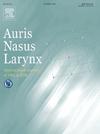Relationship between autonomic nervous system function and endolymphatic space ratio in Ménière disease
IF 1.5
4区 医学
Q2 OTORHINOLARYNGOLOGY
引用次数: 0
Abstract
Objectives
Autonomic dysfunction is associated with Ménière disease (MD) and benign paroxysmal positional vertigo (BPPV). Because the autonomic nervous system regulates blood pressure (BP) and heart rate (HR) during positional changes, these changes can be used to assess autonomic nervous system function. We aimed to evaluate the relationship between MD/BPPV and autonomic nervous system function based on BP, HR, and endolymphatic space (ELS) ratio measurements, and to examine the differences between the two diseases.
Methods
This retrospective study included 168 patients who underwent inner ear magnetic resonance imaging (MRI), Schellong test (S-test), and HR measurements and were diagnosed with MD (n = 103) or BPPV (n = 65) between August 2014 and January 2024. The ELS ratios of the entire inner ear, cochlea, vestibule, and semicircular canals were calculated using MRI. The ranges of BP and HR changes during position changes were calculated and related to each ELS ratio.
Results
Forty (38.8 %) patients with MD had a positive S-test result, which was significantly higher than the number of patients with BPPV who had a positive S-test result (n = 15, 23.1 %) (P = 0.0427, Fisher’s exact test). A trend toward a significant increase in the cochlear ELS ratio with decreasing systolic BP was observed in patients with MD with a positive S-test (Spearman’s test, r=−0.346, P = 0.0287). No significant differences were observed between the other combination groups.
Conclusion
Autonomic nervous system function may influence the onset of MD more than BPPV, furthermore, MD patients with S-test positive, a weak correlation was observed between an increased ELS ratio in the cochlear and a decrease in systolic BP.
自主神经系统功能与内淋巴间隙率的关系
目的:研究自主神经功能障碍与membroinitre病(MD)和良性阵发性体位性眩晕(BPPV)的相关性。由于自主神经系统在体位变化时调节血压(BP)和心率(HR),这些变化可用于评估自主神经系统的功能。我们旨在通过测量BP、HR和内淋巴间隙(ELS)比值来评估MD/BPPV与自主神经系统功能的关系,并探讨两种疾病之间的差异。方法回顾性研究纳入168例2014年8月至2024年1月期间接受内耳磁共振成像(MRI)、Schellong试验(S-test)和HR测量并诊断为MD (n = 103)或BPPV (n = 65)的患者。采用MRI计算全内耳、耳蜗、前庭、半规管的ELS比值。计算体位变化过程中BP和HR的变化幅度,并与各ELS比值相关联。结果40例MD患者s检验阳性(38.8%),显著高于BPPV患者s检验阳性(n = 15, 23.1%) (P = 0.0427, Fisher精确检验)。s检验阳性的MD患者耳蜗ELS比值随收缩压降低呈显著升高趋势(Spearman检验,r=−0.346,P = 0.0287)。其他联合用药组间无显著差异。结论自主神经系统功能对MD发病的影响大于BPPV,且S-test阳性MD患者耳蜗ELS比值升高与收缩压降低呈弱相关。
本文章由计算机程序翻译,如有差异,请以英文原文为准。
求助全文
约1分钟内获得全文
求助全文
来源期刊

Auris Nasus Larynx
医学-耳鼻喉科学
CiteScore
3.40
自引率
5.90%
发文量
169
审稿时长
30 days
期刊介绍:
The international journal Auris Nasus Larynx provides the opportunity for rapid, carefully reviewed publications concerning the fundamental and clinical aspects of otorhinolaryngology and related fields. This includes otology, neurotology, bronchoesophagology, laryngology, rhinology, allergology, head and neck medicine and oncologic surgery, maxillofacial and plastic surgery, audiology, speech science.
Original papers, short communications and original case reports can be submitted. Reviews on recent developments are invited regularly and Letters to the Editor commenting on papers or any aspect of Auris Nasus Larynx are welcomed.
Founded in 1973 and previously published by the Society for Promotion of International Otorhinolaryngology, the journal is now the official English-language journal of the Oto-Rhino-Laryngological Society of Japan, Inc. The aim of its new international Editorial Board is to make Auris Nasus Larynx an international forum for high quality research and clinical sciences.
 求助内容:
求助内容: 应助结果提醒方式:
应助结果提醒方式:


